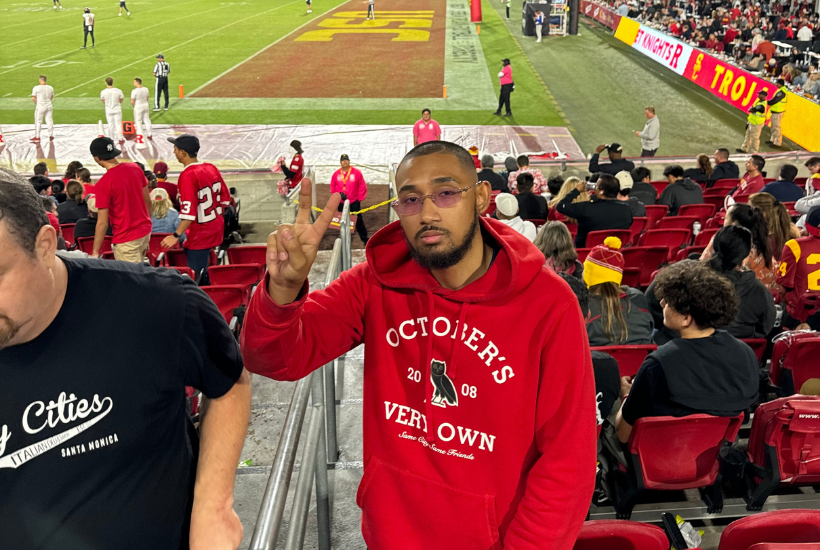In my work as director of the USC Gould School of Law Center for Dispute Resolution, I often have prospective students ask me, “Why study dispute resolution?” This question frequently comes from people with diverse life and professional/career experience, including for example, judges with many years of experience on the bench, highly skilled and experienced lawyers, successful or aspiring business owners and entrepreneurs, JD law students, undergraduate students recently completing their studies, as well as people from various areas of career focus such as human resources, education, entertainment, medical/health, insurance, real estate, banking, investment, information technology (IT) and many others. Some have had many years of professional and personal experience and have distinguished themselves in long careers. Others have relatively little or no experience, in contrast.
 |
In addition to the why question, I am often asked, “Do I really need dispute resolution education? Whether someone needs dispute resolution education is a more difficult and personal question and one I am reluctant to answer because there are so many subjective components to the analysis and response. Yet, while I am hesitant to answer the need question, I am eager to answer what I believe to be a more salient question, “Will I benefit from dispute resolution education?” To that question, I enthusiastically assert that the answer is universally affirmative. Why universally affirmative? Because, unless you live totally isolated off the grid and do not interact with any other human, you will encounter conflict. Everyone will. It is a universal fact of life. Conflict is a natural part of the human experience and has an impact on us in every aspect of our lives. My students often hear me say that conflict in and of itself is neither positive nor negative, it is how we respond to it that makes it one or the other. The why and benefit questions lead to a third question that I will consider in this article, “How will I benefit from dispute resolution education?” The information provided below will answer all three questions.
Fundamentally, people benefit from dispute resolution education by gaining a deeper understanding of issues underlying conflict and the processes available to resolve them. Students develop and practice skills needed to improve the quality of dispute resolution processes and increase the satisfaction of parties with the outcomes of those processes.
We like to think that we and most reasonable people are rational and objective in problem solving and decision making. Law students are taught to, “Think like a lawyer.” The idea is to be objective, rational and emotionally calm in objectively applying law to facts, and then reaching conclusions consistent with that analysis. Indeed, this is an important skill for law students and other dispute resolution professionals to develop. Yet when pursued in the real world, this frequently does not happen and diverse opinions often emerge as to what the correct conclusions should be.
Research studies have found over many years that people are frequently not rational when in the midst of conflict, and worse, are rarely aware they are not thinking or acting rationally. Several factors contribute to this condition.
- Psychological traps obstruct our ability, and the ability of others, to analyze and act rationally.
- Negative emotions cloud our perceptions of people and events, and impacts how we act when trying to resolve conflict.
- Societal norms prompt overly competitive thinking and behaviors, preventing us from finding solutions that would frequently be more satisfying and enduring than those reached by competitive means.
- Communication between disputants is often dysfunctional and ineffective;
- Disputants fail to effectively plan and prepare for negotiations and other dispute resolution processes;
- Cultural differences cause misunderstandings and obstruct effective communication.
 |
Psychological Traps
In litigated matters I have mediated over many years, I often ask lawyers on each side to “predict” the likelihood that their client will prevail on an issue such as liability or damages if a settlement is not reached, and the matter proceeds to trial or some other adjudicatory process. When I add up the percentage predictions of both attorneys, frequently the sum of the two predictions far exceed 100%, sometimes as high as 180% or more. Both cannot be right. Often, this happens in situations involving very experienced and competent lawyers on both sides. Of course, we also encounter that situation when one or both of the lawyers are not experienced and/or competent. But that is not what I am talking about here. How does it so often happen when experienced and knowledgeable attorneys are involved and to those who would deny that their analysis is anything but objective and rational? A full analysis of this dilemma is beyond the scope of this article but a few comments will help illuminate some probable answers.
People are susceptible to cognitive errors in thinking that frequently cause us to make mistakes in our analysis and decisions relative to important decisions we make in our lives. Research over many years has established that our minds utilize two systems of thinking. System 1 is our automatic system and allows us to recognize our environment and make numerous daily decisions without any deep thinking. Sometimes referred to as our heuristic or intuitive mind, it is the most active part of our decision-making system, is involuntary and very fast. It allows us to recognize immediately that a shirt is green or that a piece of furniture is a chair. It recognizes the noise of glass breaking, a dog barking, or a baby crying. Other examples include recognizing that one person is taller than another person, that a tree has or does not have leaves, that a body of water is wet, reading words on a blackboard or sign, distinguishing between an apple and an orange and computing 2×2. It is involuntary in that it happens automatically and you cannot stop it. Just look at a tree and try to stop yourself from recognizing it as a tree.
System 1 thinking keeps us even-keeled. It allows us to function in a complex world without being overwhelmed by stimuli not requiring deeper thought. However, System 1 can also get us into trouble if we fail to recognize when System 2 thinking is required to avoid thinking errors and making bad decisions. We might think that System 1 thinking errors could be avoided by simply paying closer attention. This is easier said than done. System 2 thinking is effortful and its constant use depletes our thinking energy and leaves us exhausted. Think about how you felt after focusing intently for a long time on an important task like taking an exam. When you were done, you were likely very tired. Being constantly vigilant makes it difficult to budget our cognitive resources and may diminish the benefits derived from System 1.
System 2 thinking is slower and effortful. Examples of System 2 thinking include, looking for a specific person in a crowd, comparing smart phones to decide which to purchase, completing a crossword puzzle, considering what color would look best on a wall, filing out a medical form, deciding what to cook for dinner and computing 27×73.
System 2 is happy to allow System 1 to answer questions or make decisions if System 1 generates a quick answer and an obvious error is not apparent. The problem is that System 1 often generates a quick answer in situations calling for deeper analysis and we fail to engage System 2 for that purpose. For example, think of the answer to the following question that comes quickly to your mind: A bat and ball cost $1.10. The bat cost one dollar more than the ball. How much does the ball cost? If you are like most people, the answer that came quickly to your mind is 10 cents and you were wrong. If the ball cost 10 cents, the bat and ball would cost $1.20. Utilizing System 2 thinking would cause you to slow down and consider that the bat cost $1.00 more than the ball. If because of the nature of this article, you suspected a trick question you may have slowed down your thinking and utilized System 2. If you did, your thinking was effortful and not automatic and even if you did, the quick answer that first came to your mind was 10 cents and it was automatic. System 2 thinking requires us to pay attention. Because System 2 is effortful, it is easy to miss situations requiring us to question information retrieved by System 1.
This problem is often exacerbated by other psychological biases that interact with System 1 in ways that subtly direct our attention away from stimuli that could otherwise prompt us to call in System 2 when needed to avoid thinking errors and making poor decisions. Examples of these other cognitive biases include, anchoring; confirmation bias; consensus error; framing; loss aversion; naïve realism; overconfidence; reactive devaluation; and selective perception. Research has shown that even those who study and research these cognitive errors often fall victim to their seductive power.
Negative Emotions
Negative emotions are another factor making effective dispute resolution difficult. Dispute resolution professionals are often uncomfortable when disputing parties are experiencing negative emotions. This discomfort frequently arises because people lack the knowledge, skills and confidence needed to assess and respond to a disputant’s negative emotions in ways that improve and do not escalate the problem. People experiencing negative emotions have trouble accurately processing information. As these emotions escalate, the ability to problem solve decreases proportionately and attention is diverted from the problems to be solved. When one’s ability to think and make rational decisions is impaired, they are vulnerable to be exploited, and prone to say and do things that escalate conflict instead of resolving it.
Equally important is the fact that people tend to underestimate the impact of their own negative emotions when engaged with others to solve problems. It is not possible to deal with another’s negative emotions if we are in the grasp of our own.
Dispute resolution education provides students with frameworks for assessing and dealing with negative emotions (others and our own). It is a lot easier to deal with these issues if you understand where they are coming from and have tools needed to address them.
 |
Overly Competitive Thinking and Behavior
Whether we think so or not, negotiation is part of everyday life. We negotiate with friends and family members over such things as where to go to dinner, what movie to see, where to go on vacation and so on. We even negotiate with ourselves as we try to decide what we are going to wear for the day. We negotiate where the stakes are much higher such as when purchasing a car or a home, or where the stakes are somewhere in between such as buying tickets to a concert or sporting event. Importantly, we also negotiate when we face conflict or are engaged in a dispute, large and small.
Many dispute resolution students enter our program with significant negotiation experience. Indeed, many have proven themselves to be very successful negotiators over many years. Some students enter the program with relatively little or no formal negotiation experience and wonder whether their lack of prior education and experience will obstruct their participation in the program. Both groups of students are usually surprised to learn that their negotiating knowledge and skills are significantly improved, especially as it relates to dispute resolution and problem solving. Dispute resolution education expands a student’s vision of negotiation beyond a traditionally engrained paradigm of competition and provides insights and frameworks for negotiation that creates value and increases the quality of negotiation agreements.
Regardless of the extent of our negotiating activity, we live in a society and at a time where most people think of negotiation as a competitive activity. When buying a car, we want to get the lowest price possible and the automobile dealer wants to get the highest price reasonably achievable. For every dollar we save, the dealer loses and vice versa. It is a zero-sum interaction. Competition is a concept learned from the very earliest years of our lives.
Children grow up playing board games, sports and compete for places on teams, performing groups or to become members of a club. They play dodgeball, kickball, football, baseball, basketball, soccer, hockey, etc. They run races and compete in costume contests. We have bake-offs, cook-offs, and BBQ competitions. We root for our favorite teams to win and for our rivals to lose. We want to win and we want those we care about to also win. And in most of these situations, there are winners and there are losers.
In some contexts where relationships matter people may temper their competitive impulses. If my granddaughter and I both want the last buttermilk biscuit at the dinner table I will likely yield the temptation to be competitive. I will also frequently yield when a family member prefers a particular movie or choice of activity. Aside from situations where we yield or avoid negotiation because the issue not that important or it is our disposition to avoid conflict, unless taught otherwise, negotiation is regularly viewed through a competitive lens.
One of the most compelling learning moments I see in dispute resolution students occurs when they are first introduced to the concept of interest-based or principled negotiation. The prototypical example of this concept is found in the popular book, Getting to Yes, by Fisher, Ury and Patton. It is the negotiation about an orange. Two equally entitled people are competing for an orange. Efforts to resolve the conflict usually follow the typical competitive path with the ultimate outcome resulting in the equal division of the orange. Each person gets half.
The competitive lens is expanded and the important paradigm shifting lesson is illuminated when the problem solver questions the parties beyond the scope of their positions (demand for the orange) and asks “why” each party wants the orange. One person responds that they are hungry and want the fruit to eat. The other says they are baking a cake and want the peel for the frosting. Under these circumstances, by determining the reasons or interests underlying the party’s positions, both parties receive 100% of what they need from the orange. Instead of assuming the negotiation was zero sum and merely cutting the orange in half, the pie was expanded, value was created, and the ultimate outcome was improved for both parties. This is called interest-based negotiation.
This is just one very small example of what students learn about negotiation theory and practice. Students not only learn about the various theories of negotiation and practice, but also engage in simulations and activities empowering them to deepen their knowledge and increase their skills in applying these principles, for themselves and others.
 |
Dysfunctional and Ineffective Communication
Lawyers are often viewed as good talkers. It is common to think of good lawyering in the context of great oration. On TV, in movies, in the news and in history, we are impressed by the brilliant performance of a legal gladiator delivering a stirring closing argument in a highly charged court trial, or when listening to, or reading, a compelling presentation by an attorney appearing before the Supreme Court. Good oration skills – and the ability to think on your feet while doing so – are extremely important for a lawyer, especially one who regularly appears in court. However, the importance of this skill often obscures the equally if not more important need for lawyers to develop good listening skills, and to have the judgement to know when listening should be used more than talking, which is most of the time.
Effective dispute resolution practice requires good listening skills. That sounds easy enough, but people frequently think they are better listeners than they are. Good listening requires much more than just hearing sounds. Passive listening happens when one is entertained by the magnificent sounds of an orchestra or the music of a favorite band or Broadway Musical. Passive listening also occurs in disputes when one is thinking and planning their response to what another person is saying while the other person is providing their perspective about the issues of a dispute. The failure to utilize good listening skills in dispute resolution not only deprives one of essential information, it also negatively impacts the feelings and emotional state of the person not being listened to. When someone feels that they are not being listened to or heard, negative emotions develop and as previously discussed, negative emotions obstruct effective problem solving.
The hearing required of dispute resolution professionals is called active listening. It not only serves the purpose of gaining information, but also facilitates the professional’s establishing trust and rapport with disputants they are serving. This not only applies to people in conflict, but also to neutrals such as mediators as well as to advocates representing clients in such processes. People in conflict have an essential need to feel as though they have been heard and understood. Active listening not only empowers one to hear what another is saying, but to learn the deeper meaning behind the words by paying close attention to the non-verbal aspects of communication. Active listening activates more than our ears. Our posture, facial expressions and engagement with the other person are essential elements of active listening. In that way active listeners are better able to learn what the interests are of the other party; the needs, desires, fears and wants underlying their stated position. Active listening also empowers people to form better questions. Appropriate and effective questions communicate to the other person what I call, “enthusiastic curiosity.” This includes a sincere desire to understand what another person is saying and why they are saying it; to have a deeper understanding of their perspective and their thinking in arriving at that perspective.
Dispute resolution students are taught essential skills associated with active listening and are empowered to develop and increase these skills through simulations and other experiential learning.
Poor Planning and Preparation
It has been said that a failure to plan is a plan to fail. This equally applies to poor planning and preparation which frequently occurs because people are uninformed as to what good planning and preparation looks like. Good planning and preparation require one to know the components of these tasks. Dispute resolution students learn what is necessary to effectively plan and prepare for negotiations, mediations, arbitrations or other dispute resolution processes.
Cultural Awareness and Proficiency
We are fortunate to live in a society with people representing diverse cultural backgrounds, experience, values and systems of communication and approaches to dealing with conflict. While this enriches our lives in many ways, it also makes it imperative that dispute resolution professionals develop cultural awareness and proficiency when interacting with people from these diverse populations.
It is my hope that the information provided in this article will give the reader some insight into how dispute resolution education transforms a student’s thinking and behaviors when dealing with conflict, whether their own, or that of others.

















